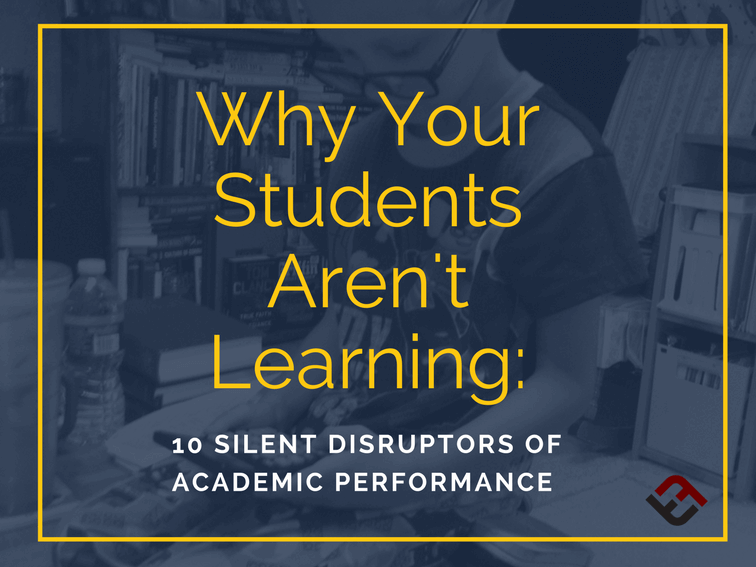Why Do You Have Struggling Students? Some Possibilities
by Terry Heick
The reality of learning in today is a matter of perspective, but it’s clear that most K-20 learning environments are teacher-led and academic (as opposed to self-directed and authentic).
While we often write about new ways to learn using new thinking, new models, and new technology, there is absolutely a role for teacher-led, academic learning in the 21st century; being ‘led by the teacher’ isn’t always a bad thing.
In fact, the role of the human being is likely to becoming increasingly important in education no matter how deeply technology is infused in the learning process. While content-area expertise may seem to be less important with modern access to information, no matter how intelligent adaptive learning models become in the next ten years, nothing will surpass the intimacy of a human being—a person that can view and adjust the persistent interaction between a student and content.
See also It’s Time To Plan For Struggling Students From The Beginning
It is in this ‘teacher important’ and highly-academic context that we’re going to take a look at common disruptors of academic performance.
The pedagogical approach of curriculum–>teacher–>student rewards efficiency, data extraction, and meaningful responsiveness to that data. This naturally makes some things (assessment and feedback) more important than others (grading).
In terms of student performance in the classroom (which is different than how deeply they understand content), there are a variety of potential disruptors. Two of the most powerful of these are basic literacy skills and socioeconomic status, facts that have spawned dozens of programs over the years—including Title I—in response.
It is likely clear to most educators then that reading levels and poverty impact academic progress, as do peer pressure, self-confidence, personal events in students’ life, the luck of the draw in terms of what peers and teachers a student gets assigned to, and dozens of other factors. It’s not all on you.
Only it kind of is, because these all are ‘excuses’ in this modern—and dangerous—game of accountability in education.
See also 6 Factors Of Academic Achievement
No matter the circumstances, every student deserves the best education possible—a fact both swelling with rhetoric and absolutely true.
Which means as educators we have to understand many of the potential barriers to both understanding and classroom performance. So below we look at 10 of the less common, ‘silent’ disruptors of student academic performance—factors that move beyond literacy, poverty, lack of technology access, and other admittedly powerful but already widely disseminated ideas.
Note, two of the more common reasons students aren’t learning (reading level, student engagement/motivatio) are well-covered and well-known. This post is about the less-obvious factors that could harming student performance.
10 Silent Disruptors Of Student Academic Performance
10. Student Disorganization
Every teacher has that student—the one that comes into the classroom with a pile of papers stacked high enough to hide their face as they waddle in.
Middle school teachers especially have seen the way disorganization can impact note-taking (unlikely), note-keeping (ha!), and careful study of notes and other learning materials that can result in understanding of content, and thus academic success.
9. Student Work Not Within ZPD
Without differentiation or personalized learning, for the majority of the class any work given will likely fall outside of their Zone of Proximal Development.
In the same way it wouldn’t stress a marathon runner to run three times around the block, nor would it makes sense to have them run a thousand miles, choosing the right work at the right time in just the right amount can be a huge boon not only to student understanding, but long-term classroom success.
8. Poor Response to Data
We’ll talk more about data below, but suffice to say that while teachers are getting better at extracting, analyzing, and sharing data, meaningfully responding to that data in a timely manner every single day is another matter entirely. (If for no other reason that it’s difficult to find the time to consistently do so.) Still, timely, meaningful, and consistent responses to data are crucial to student learning even if there are Inconvenient Truths About Assessment.
See also 8 Common Sources Of Formative Assessment Data
7. Lack of Specificity and/or Clarity
Whether it’s a lack of clarity in learning goals, muddy procedures, difficult-to-follow teacher questioning, a confusing instructional sequence, or a disconnect between a literacy strategy and the content to be learned, it very well may be that you make sense to most of the class while still leaving 1/3 or more behind—a large portion that learns to smile, give eye-contact, and ask cursory questions, then seek out peers to fill in the gaps the best they can.
6. Imbalanced Teacher Content Knowledge vs Pedagogical Knowledge
Or a disconnect between the learning goal and the planned lesson.
Many teachers are experts—or near experts—in their content areas, passionate life-long learners that eat up every science essay, literary magazine, or war monument they can find.
Others are ‘master teachers,’ engrossed in the planning of authentic learning experiences for students.
Very, very few teachers are both. At some point, one or another takes hold in a teacher’s professional pathway, making it easy to lose sight of the other. When that happens, some area of student learning will suffer: dry, irrelevant expertly delivered content, or interesting, critical poorly-packaged learning activities.
And both can disrupt academic performance.
5. Curriculum Mapping Mistakes (no iteration, practice, awkward sequencing, etc.)
Curriculum maps aren’t staid and static documents for you to adhere to and ‘be compliant with district expectations’—or rather they shouldn’t be. A well designed—and responsive and flexible—curriculum map is your friend. Mistakes at the curriculum planning level can take years for teachers and students to overcome.
4. Unmanageable Data
You may have data, but it’s incredibly time-consuming to extract. Planning, designing, and producing the assessment, then administering it (with make-up assessments), evaluating student performance (i.e., grading it), organizing learning feedback in a way that makes sense and it helpful to students, then reporting said progress (i.e., entering grades), then taking that data, repackaging it in a way that can be visualized and comprehended, then performing item analyses, making inferences about missed questions and distractors, etc., then taking all of that data and modifying and personalizing planned instruction for each student—and doing all of this consistently—is a significant burden even with technology.
The first step in mitigating this elephant-in-the-classroom of problematic data is to make it more manageable on a consistent basis, and simply organizing teachers into “data teams” is a decent but ultimately insufficient response.
3. Assessment Design
The test results may show weak academic performance, but it could be because the test isn’t assessing what you think it is. Or you’ve chosen an assessment form that only obscures what students understand rather than letting them show it.
If you suspect students know more than they show, you might be right–and this could be a big reason why.
Assessment design is one of least well-understood areas of pedagogy. For an overview, there are many, many ways to measure understanding.
2. Limited practice transferring knowledge
You may have done well explaining what a thesis statement is and is not, where they do and do not belong, and why every argument essay needs one, but students may have no idea why having a position on a given issue is important, much less how to communicate it and what on earth that has to do with a column on a rubric you just handed them.
Moving from big picture—the why and when—to the little picture—exactly how—can help those students that struggle to make that kind of transition themselves. Some students are detailed, micro-thinkers, while others are design-level, big picture surveyors. This means you need to move back and forth as often as you want them to.
This is a kind of transfer, and transfer both reflects and strengthens understanding.
See also 14 Ways Students Can Transfer What They Know
1. Student Understanding/Minimal Depth to Knowledge
Whether you use Bloom’s Taxonomy, Depth of Knowledge, Understanding by Design’s 6 Facets of Understanding, TeachThought’s Learning Taxonomy, or something else entirely, not all understanding is created equal.
While a student may be able to define tone, or perimeter, or immigration, or mitosis, or any number of other content strands, being able to transfer that understanding—to use that knowledge in new and unfamiliar situations without prompting—is another matter entirely.
Simply put, students that deeply understand content—and the context of that content—are far less likely to underperform on an assessment, struggle to complete assignments, or perform poorly in school.

